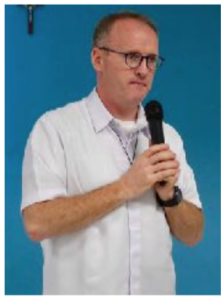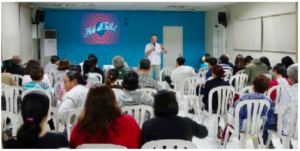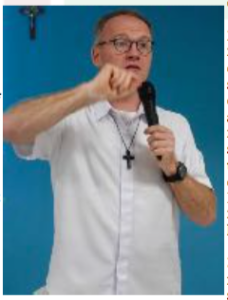Fr. James McTavish Expounds on Same Sex Attraction and Homosexuality
 Fr. James McTavish FMVD of Verbum Dei, CTK’s regular facilitator for the School of the Word every Wednesday morning, was the speaker during the Living Hope Prayer Community’s talk last November 13 on ‘Love and Same Sex Attraction: Understanding the View of the Catholic Church’. Although Living Hope is not one of the recognized renewal movements of CTK, the group holds regular meetings at CTK, including its weekly Timothy Youth Ministry, and includes among their leaders Sonny and Mina Mejia, CTK’s Mustard Seed Ministry lead couple.
Fr. James McTavish FMVD of Verbum Dei, CTK’s regular facilitator for the School of the Word every Wednesday morning, was the speaker during the Living Hope Prayer Community’s talk last November 13 on ‘Love and Same Sex Attraction: Understanding the View of the Catholic Church’. Although Living Hope is not one of the recognized renewal movements of CTK, the group holds regular meetings at CTK, including its weekly Timothy Youth Ministry, and includes among their leaders Sonny and Mina Mejia, CTK’s Mustard Seed Ministry lead couple.
Fr. James began by stating that the Catechism of the Catholic Church defined homosexuality as the relations between men or between women who experience an exclusive or predominant sexual attraction towards persons of the same sex. He then expounded on three key points:
 1. First, that current perceptions of the prevalence of homosexuality in society are way overblown. To prove it, he asked the audience what they thought was the ratio of homosexual, gay, bisexual and transgender people compared to the general population. A few said 10% while the majority said 20% or 25%. In fact, he showed the 2014 study by the Center for Disease Control, or CDC, which revealed only 3% of the US population identified themselves in a private survey as being in the gay- lesbian-bisexual group. And what was the cause of the great disparity, he asked the crowd. It’s the media and it’s the assertiveness of this tiny community with their lobby groups that make them seem much larger than their actual headcount. Watch any noontime show or afternoon variety show on TV, he said, and chances are, you have gay hosts, interviewing gay guests, holding Ms. Gay Philippines and similar cross- dressing competitions. Our media is ‘super-saturated’ with gay people, argued Fr. James.
1. First, that current perceptions of the prevalence of homosexuality in society are way overblown. To prove it, he asked the audience what they thought was the ratio of homosexual, gay, bisexual and transgender people compared to the general population. A few said 10% while the majority said 20% or 25%. In fact, he showed the 2014 study by the Center for Disease Control, or CDC, which revealed only 3% of the US population identified themselves in a private survey as being in the gay- lesbian-bisexual group. And what was the cause of the great disparity, he asked the crowd. It’s the media and it’s the assertiveness of this tiny community with their lobby groups that make them seem much larger than their actual headcount. Watch any noontime show or afternoon variety show on TV, he said, and chances are, you have gay hosts, interviewing gay guests, holding Ms. Gay Philippines and similar cross- dressing competitions. Our media is ‘super-saturated’ with gay people, argued Fr. James.
2. Second, admittedly, given the onslaught of social media, youth today can be conflicted as to their sexuality. In a study of American youth, over one fourth of 12 year olds were unsure if they were heterosexual or homosexual. Why the ambivalence, he asked. The evidence for genetic disposition is scant, Fr. James argued, while the evidence for the role of ‘environment’ and ‘nurture’ is strong. Of course, there will be boys who are more artistic, creative, with poorer motor skills and unfortunately, society will already pre-label them as potentially gay. Aside from prevalent media, you have – poor relationship with fathers and-or mothers; sexual abuse by an older homosexual male; labeling by peers, parents, teachers, etc. during their formative childhood period. This usually results in difQiculty in bonding with same sex friends that further aggravates the situation. He also argued that sexual orientation is about feeling and feelings can change. For example, a boy can have a temporary infatuation with an inspiring male teacher, but that doesn’t mean he’s homosexual. So asking young people to ‘come out’ because they think they might be gay when in fact, only 3% of the population are indeed homosexual means that 97% of the time, you will be wrong.
3. And third, there is a insidious ‘ideology of gender’ that keeps attempting to put gender identity and sexual orientation front and center, when in fact, gender identity and sexual orientation are but one aspect, not even an essential aspect of a person’s humanity. No one should ever be introduced as gay or homosexual. First, a person is a child of God. Then he or she’s a parent and-or a child; then he or she’s a student, or teacher, or priest, or office worker, or laborer. The person can be defined by his physical sex, his height, his skin color, his racial heritage, his IQ, his sociability, and many other things. Cardinal Ratzinger himself reminds us that ‘the human person, made in the image and likeness of God, can hardly be adequately described by referencing his sexual orientation.’ Fr. James argued that it is only today where a person can be a male – genetically, anatomically, physically, physiologically – yet one piece of data can override all that information. And that’s the person’s feelings – ‘I don’t feel male, I feel female’. Fr. James asked everyone, ‘Can that one feeling override all the other data?’ He struck the analogy of the child telling his parent that he feels he’s superman. Would that parent allow her child to climb up to the roof and jump, just because he ‘felt’ he could fly?
What does the Catholic Church say?
 ‣ First, the sexual orientation is not in itself sinful. But engaging in the homosexual act is. Why? When a homosexual male is promiscuous and engages with several partners, it can only bring him harm. The typical number of partners by a sexually active homosexual male is 700, based on a recent survey. This can’t possibly be healthy, with the risk of sexually- transmitted disease like syphilis, gonorrhea, and HIV. Fr. James once gathered a group of gay men and asked them, ‘If a man and a woman can fall in love, get married, and stay in love till their old age, can’t the same thing happen between two men who ‘fall in love and stay in love’. The reaction from the group surprised him, he confessed. The group said in one voice, Father, we have never ever met a faithful gay man.’
‣ First, the sexual orientation is not in itself sinful. But engaging in the homosexual act is. Why? When a homosexual male is promiscuous and engages with several partners, it can only bring him harm. The typical number of partners by a sexually active homosexual male is 700, based on a recent survey. This can’t possibly be healthy, with the risk of sexually- transmitted disease like syphilis, gonorrhea, and HIV. Fr. James once gathered a group of gay men and asked them, ‘If a man and a woman can fall in love, get married, and stay in love till their old age, can’t the same thing happen between two men who ‘fall in love and stay in love’. The reaction from the group surprised him, he confessed. The group said in one voice, Father, we have never ever met a faithful gay man.’
‣ Second, in the words of Pope Francis in his book ‘The Joy of Love’, ‘denying the difference between a man and a woman and envisioning a society without sexual differences is contrary to the anthropological basis of the family.’ In the same book, Pope Francis said, ‘Same sex unions, for example, may not simply be equated to marriage.’ The CBCP weighed in similarly. ‘Males and females are meant to complement each other in a union of the two. And human sexuality, characterized as distinctly masculine or feminine, is ordered by nature towards that union, of one specifically with the other.’
‣ Fr. James also sought to correct the misimpression about an often-used quote from Pope Francis. What’s in the popular literature is ‘Who am I to judge?’ Actually, Fr. James clarified, the whole and correct sentence was, ‘If a person is gay and seeks God and has good will, who am I to judge him?’ Which gives a different meaning and tone to what he was trying to say.
In terms of prescriptions, Fr. James offered several.
1. Prayer – praying for people with same sex attraction and they praying for direction – was number one. Prayer, argued Fr. James, can keep the mighty force of human sexuality under control. He quotes Scripture, ‘Do not fall into the grip of your passion. Fierce passion destroys its owner’.
2.He also argued strongly for continuing formation, especially for those with same sex attraction. He cited the COURAGE apostolate, which was formed for persons with same sex attraction trying to be chaste, with the help of the community, while ENCOURAGE was created for parents with children having same sex attraction.
3.He encouraged young men and women with same sex attraction to develop healthy non-sexual friendships – and to create strict lines and boundaries.
4. Lastly, he strongly advised to avoid discriminating against persons with same sex attraction. They must be accepted with respect, compassion and sensitivity. Even the Catechism of the Catholic Church had strong views on the subject – ‘Every sign of unjust discrimination in their regard should be avoided (CCC 2358)’.
